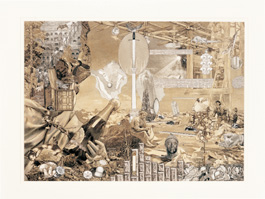home | metro silicon valley index | the arts | visual arts | review

The JPMorgan Chase Art Collection/© The Jess Collins Trust, Berkeley, CA. Photo courtesy of the JPMorgan Chase Art Collection
Data overload: Jess' collage 'Cover for The Mutabilities' is packed with visual action. Click here to see a full-size version of the above pic.
Cutting-Edge
The paste-up art of Jess layers found words and images into dense universes of mystery and delight
By Michael S. Gant
IN HIS collage Alone in a Crowd (1968), artist Jess illustrates nostrums from an etiquette manual with found images. In one segment, a muscle man wrestles with a pair of giant scissors. That man might be Jess (1923-2004) himself. No one wielded scissors like Jess, who cut apart old magazines, catalogs and newspapers, appropriating images and gluing them together in staggeringly complex creations that he called "paste-ups."
Jess, who lived in and around San Francisco with the poet and gay icon Robert Duncan since the late 1940s and was a major player in the city's bohemian renaissance, raised the art of collage to dizzying heights. He was also an accomplished painter and illustrator, as well as a tireless collaborator on the myriad of small magazines that were so important to San Francisco's literary history. A representative sprinkling of his works can be seen in a traveling show now at the San Jose Museum of Art.
Jess, born Burgess Collins, began as a scientist, not an artist. After attending Cal Tech as a chemistry student, he was drafted and assigned to the Manhattan Project, producing plutonium. Troubled by an apocalyptic dream he had in 1948 about a nuclear holocaust that would wipe out Earth in 1975, Jess enrolled at the San Francisco Art Institute, changed his name, moved in with Duncan and started making art.
Jess' early collages combine typography from headlines into Dada-like nonsense poetry interspersed with quirky magazine cutouts (Life and 19th-century copies of Scientific American being his favorites). Boob #3 (1954) shows how Jess crowds his paste-ups with visual and linguistic flotsam. The thick accumulation of images makes the paper buckle under the load of glue necessary to hold them in place.
Jess continued to play with words, most notably in his Tricky Cad series. Carefully cutting up the word balloons from Dick Tracy comic strips, he rearranged the lexical elements to turn the crime-stopper into an avant-garde absurdist who spouts puzzlers like "I don't like a perfect drowning at the base of my skull."
Later, Jess let the words fall by the wayside and concentrated on accumulating layer upon layer of images. In these increasingly complicated constructions (done as broadsides, book covers and stand-alone art pieces), tiny worlds proliferate. His Cover for The Mutabilities, for instance, sends miniature black sedans careening across piano-keyboard roadways past monumental crystal formations while a champagne bottle the size of Big Bertha erupts and a locomotive chugs out of a tunnel toward an erupting oil derrick.
The paste-ups culminate in all-color, all-image works of grandiose size. The show boasts one prime example: Dyslecstasy, a collage from 1991 that is bewildering in its cascade of floating bodies, disembodied hands, lips, leaves, Mayan calendar wheels, eyeballs ad infinitum. Some of the individual pieces are smaller than a postage stamp. There is no right place to begin—just plunge in anywhere and follow your own trail.
The show also contains examples of Jess' "translations," salvaged paintings and photographs that the artist replicated in a thick, colorful impasto; his symbolist oil paintings; and one of his cheeky sculptural assemblages—a teapot sporting antlers and a gas-station Pegasus.
But the paste-ups are what grab and hold you. It is possible to "read" these panoramas for hours and not run out of new discoveries. Their roots lie in the surrealistic dream collages of Max Ernest, but Jess went way beyond Ernst in his obsessive palimpsests. They are, in the best sense of a debased word: psychedelic.
Jess' innovations ripple through Bay Area art. His influence can be seen in Wilfried Sätty, a 1960s cult figure who compiled a secret collage history of San Francisco; in montage specialist Winston Smith, who does for album covers what Jess did for books; and in Burning Man artist David Best, who fashions 3-D shadow-box collages from old engravings.
Jess: To and From the Printed Page runs through June 10 at the San Jose Museum of Art, 110 S. First St., San Jose. (408.294.2787)
Send a letter to the editor about this story.
|
|
|
|
|
|